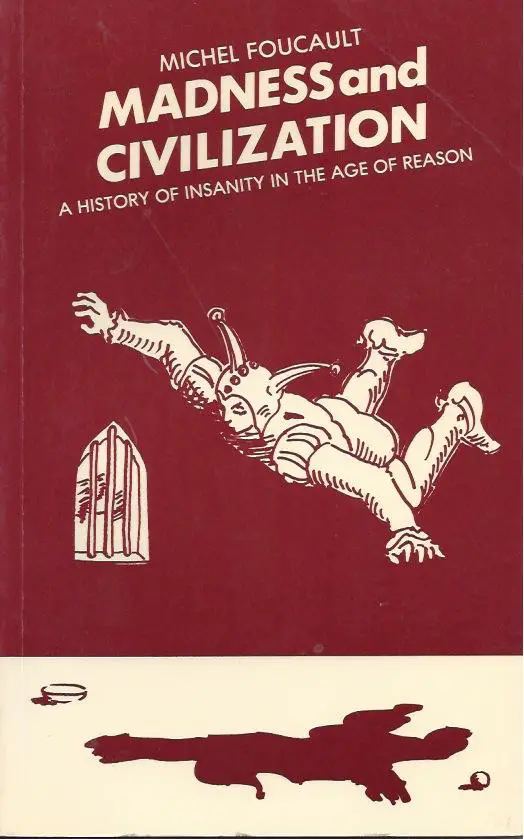Michel Foucault’s Madness and Civilization: A History of Insanity in the Age of Reason (1961) critically examines the history of madness in Western Europe, tracing the development of its treatment and cultural perception from the Middle Ages to the 19th century. Foucault’s core argument is that madness is not an objective or natural phenomenon but is socially constructed, with shifting definitions and treatments serving as a reflection of power relations, societal norms, and epistemological shifts.

Major Themes and Ideas
The Great Confinement (17th Century)
Foucault begins his analysis by focusing on the large-scale institutionalization of marginalized groups during the 17th century, a phenomenon he terms the “Great Confinement.” This process saw the creation of state-run institutions, like the Hôpital Général in France, which housed a wide variety of individuals deemed socially undesirable—beggars, the poor, criminals, and the insane. Foucault emphasizes that this mass confinement was not driven by a humanitarian impulse to care for the mentally ill, but by a need to control and regulate behaviors that threatened the emerging social and economic order. In this new age of mercantilism, those who did not contribute to the productive labor force were viewed as threats to the stability of society. The confinement of the mad, therefore, was part of a broader social project aimed at marginalizing non-productive elements and instilling discipline in them.
“In the 17th century, a strange act of massive internment was seen. The aim was not to cure or even to understand the mad but to control them by means of confinement and exclusion from the productive workforce” (Foucault, 1961).
The Great Confinement was not a medical response to mental illness but a political and economic one. Madness was lumped together with other forms of social deviance, reinforcing the notion that the mad were part of a broader class of individuals who were seen as non-conformists or threats to the social order.
The Classical Age and the Birth of Reason
In the Classical Age (the 17th and 18th centuries), Foucault notes a significant epistemic shift in the treatment of madness. As the Age of Reason gained prominence, the division between reason and unreason became sharper. Madness, which in earlier periods had been regarded with a certain ambiguity—sometimes feared, sometimes venerated—became firmly categorized as “unreason.” This period witnessed the marginalization of madness not just physically, through confinement, but symbolically, through its exclusion from the realm of valid knowledge and discourse.
The Enlightenment’s faith in reason, science, and progress led to a new understanding of madness as the absolute antithesis of reason. According to Foucault, this dichotomy enabled the systematic exclusion of the mad from public life and intellectual debate. The treatment of madness became a matter for the growing field of psychiatry, which defined itself as the protector of reason. The mad, by being excluded from rational discourse, were also denied subjectivity, their voices were considered unintelligible.
“The Classical Age demanded a clear boundary between reason and unreason… Unreason became something that had to be corrected or excluded for reason to assert itself fully” (Foucault, 1961).
Foucault emphasizes that this transformation was not a neutral or purely scientific development. It reflected the rise of new power relations in society, where the legitimacy of certain forms of knowledge (like reason) was constructed in opposition to what was considered irrational or deviant.
The Role of Work and Morality in Confinement
A crucial part of the confinement of the mad involved the imposition of moral reform through labor. Foucault argues that confinement institutions functioned as sites of moral instruction, where the mad and other confined individuals were subjected to regimes of discipline. These institutions were not primarily about medical treatment, but about correcting behavior through forced labor, seen as a path to moral redemption. The view of madness as a moral failing was tied to broader societal values that equated productivity with virtue.
Foucault shows how labor became a tool of power within these institutions. Those who were confined were put to work, often under harsh conditions, as a means of disciplining their minds and bodies. The confinement system aimed not to understand or cure the mad, but to transform them into productive and compliant members of society through moral reformation.
“In the houses of confinement, labor became not just a means of economic survival but a method for morally reforming the person. Work was imposed on the mad as part of their correction and discipline” (Foucault, 1961).
This imposition of work reflected broader societal shifts towards capitalism and the need for a disciplined, productive labor force. Those who did not conform to the emerging work ethic were treated as deviant and subjected to institutional control.
The Age of Asylums and the Medicalization of Madness
In the 19th century, with the rise of psychiatry, the confinement of madness was transformed into what Foucault calls the “Age of Asylums.” This shift marked the beginning of what is often seen as the medicalization of madness. However, Foucault challenges the idea that this represented progress in the treatment of the mentally ill. He argues that the asylum was not a space of healing, but rather a new mode of control. The role of the physician became central, and the mad were no longer treated as simply morally deviant; they were now considered medically abnormal.
Foucault’s critique here is that psychiatric power replicated many of the mechanisms of control found in earlier forms of confinement. While the asylum was ostensibly focused on treatment, it operated through similar principles of discipline, surveillance, and exclusion. The mad were isolated from society, not just for their own benefit but to maintain social order.
“The asylum created the illusion of medicalization but in fact continued the process of exclusion. The mad were subjected to new forms of control under the guise of psychiatric authority” (Foucault, 1961).
In this sense, psychiatry did not liberate the mad but transformed their subjugation into a more insidious form, justified by medical knowledge. The doctor’s gaze replaced the guard’s watch, but the underlying logic of exclusion remained intact.
The Symbolic Role of Madness in the Renaissance
Before the Enlightenment’s sharp distinction between reason and unreason, Foucault argues that madness held a more complex and ambivalent position in society, especially during the Renaissance. During this period, madness was often linked to wisdom, insight, or folly, and it appeared in cultural artifacts like art and literature. In works like Erasmus’s In Praise of Folly, madness was portrayed as a mirror to human folly, providing an important critique of social norms and values. In this way, madness was not entirely silenced but played a symbolic role in exploring the limits of human knowledge and behavior.
Foucault notes that Renaissance art, particularly in the works of artists like Hieronymus Bosch, portrayed madness as part of the human experience. It was not something to be excluded or treated, but something that revealed deeper truths about human existence and the world.
“In the Renaissance, madness was not simply excluded; it held a place in the world, embodying the complexity of human nature. Through its association with folly, madness offered insights into the limits of reason itself” (Foucault, 1961).
This symbolic role of madness in the Renaissance stands in stark contrast to the later periods where madness was increasingly pathologized and excluded from meaningful discourse.
Critique of Enlightenment Rationality
Foucault’s critique of Enlightenment rationality is central to his broader philosophical project. He challenges the conventional narrative that the Enlightenment represented a triumph of reason, arguing instead that it also entailed the systematic repression of madness. While the Enlightenment is often celebrated for advancing scientific knowledge and human freedom, Foucault contends that it simultaneously constructed a new system of power that marginalized those who did not conform to the rational, productive ideal.
Madness, in the Enlightenment’s schema, was the ultimate “other” of reason. By excluding and controlling the mad, society defined the boundaries of acceptable behavior and thought. This process of exclusion was not a step toward greater freedom but rather a way of reinforcing new forms of social control under the guise of reason and progress.
“Reason’s victory in the Enlightenment came at the cost of silencing unreason. The madness that had once occupied a symbolic space was now locked away, both physically and intellectually” (Foucault, 1961).
Foucault sees the Enlightenment as the moment when the power of reason became totalizing, marginalizing other forms of knowledge and expression, including madness, as dangerous and deviant.
The Ship of Fools and Madness in Transit
One of the most evocative symbols Foucault uses to describe pre-modern attitudes toward madness is the “Ship of Fools.” In medieval Europe, the mad were sometimes sent adrift on ships, literally floating outside of society. This practice represents a different kind of exclusion: rather than being locked away, the mad were physically separated from society but still visible, as figures of fascination and fear.
Foucault’s use of this metaphor captures the ambiguity of madness before it was fully pathologized. The mad, though marginalized, were not entirely out of sight or out of mind. They occupied a liminal space, both feared and revered, embodying society’s anxieties about the unknown and irrational.
“The madman, wandering without home, drifting on the ship of fools, was both excluded from society and yet ever-present as a reminder of the fragility of human reason” (Foucault, 1961).
This symbolic exclusion contrasts with the totalizing confinement and medicalization that would come later, showing a shift from a more ambivalent approach to one of strict regulation and control.
Conclusion
Madness and Civilization is a critical exploration of how Western society has dealt with the concept of madness, and through it, Foucault exposes the power dynamics that shape social institutions and knowledge. Madness, he argues, has been continuously redefined by society’s need to exclude and control deviance, with psychiatric power merely representing the latest iteration of this exclusionary practice. Throughout the history Foucault recounts, madness serves as a mirror to society’s evolving norms, fears, and strategies of control. The book remains a seminal critique of how knowledge and power intersect in the shaping of human subjectivity.
“The history of madness is the history of the other of reason: its silencing, confinement, and medicalization… It tells us as much about society’s self-understanding as it does about those it excludes” (Foucault, 1961).
References
Foucault, M. (1961). Madness and civilization: A history of insanity in the age of reason. Pantheon Books.


